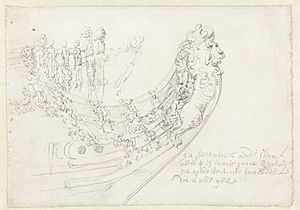English ship Elizabeth (1647) facts for kids

|
|
Quick facts for kids History |
|
|---|---|
| Name | Elizabeth |
| Builder | Peter Pett I, Deptford Dockyard |
| Launched | 1647 |
| Commissioned | 1648 |
| Name | Elizabeth |
| Acquired | May 1660 |
| Honours and awards |
Orfordness 1666 |
| Fate | Burnt in action with Dutch 5 June 1667 |
| General characteristics | |
| Class and type | 38-gun fourth rate |
| Tons burthen | 475+15⁄94 bm |
| Length | 101 ft 6 in (30.9 m) keel for tonnage |
| Beam | 29 ft 8 in (9.0 m) |
| Depth of hold | 14 ft 10 in (4.5 m) |
| Sail plan | ship-rigged |
| Complement |
|
| Armament |
|
Elizabeth was a powerful 38-gun warship from England. She was known as a "fourth-rate" ship. This meant she was a medium-sized warship with many cannons. Elizabeth played a part in important historical events. These included the English Civil War and the Anglo-Dutch Wars. She was built to protect England's interests at sea.
Elizabeth was the second ship to have this name. The first Elizabeth was a smaller 16-gun ship. It was in service from 1577 to 1588.
Contents
Building the Elizabeth
Elizabeth was built at Deptford Dockyard. This shipyard was located on the River Thames. Peter Pett I, a master shipbuilder, guided her construction. She was launched in 1647.
Her main measurements were:
- Length: 101 feet 6 inches (about 30.9 meters)
- Width (beam): 29 feet 8 inches (about 9 meters)
- Depth of hold: 14 feet 10 inches (about 4.5 meters)
Her size was calculated as 475 tons. This was a special way of measuring ships back then.
Ship's Cannons and Crew
When Elizabeth was first built in 1647, she carried 38 cannons during wartime. She carried 32 cannons during peacetime. By 1666, her wartime cannons increased to 40. These included:
- 12 culverins (large cannons)
- 20 demi-culverins (medium cannons)
- 8 sakers (smaller cannons)
The number of sailors and soldiers on board also changed. In 1652, she had 150 crew members. This number grew to 160 a year later. By 1660, her crew size was about 130 people.
Elizabeth's Time at Sea
Elizabeth served during a very busy time in English history. She was involved in conflicts like the English Civil War and wars against the Dutch.
Serving During the English Civil War
In 1648, Elizabeth joined the Parliamentary Naval Force. Her first captain was Jonas Reeves.
- In November 1648, she helped recapture a ship called Crescent.
- In 1649, she took part in blocking the port of Kinsale in Ireland.
- In 1650, she sailed with Admiral Robert Blake's fleet near Cadiz.
- In 1651, she operated in the English Channel.
After the English Civil War, England became a Commonwealth. Elizabeth joined the Commonwealth Navy.
- In 1652, she sailed to the Mediterranean Sea with Badiley's Squadron.
- On August 28, 1652, she was at the Battle of Montecristo. This was a Dutch victory. The squadron had to find shelter at Elba.
- She was also at a battle off Leghorn on March 4, 1653.
- Later in 1653, Captain Christopher Myngs commanded her in England.
- In 1656, Captain Robert Coleman took command.
- In 1659, Captain John Grimsditch commanded her for operations in the Sound.
After the King Returned (1660)
In May 1660, the monarchy was restored in England. Elizabeth continued her service.
- In June 1660, still under Captain Grimsditch, she operated in the Straits.
- On May 1, 1664, Captain Edward Nixon took command. He served until his death in May 1665.
- On May 18, 1665, Captain Robert Robinson commanded her at Tangier.
- She captured a Dutch merchant ship in the English Channel.
- On April 9, 1666, Captain Charles Talbot commanded her. She escorted a group of ships (a convoy) to Lisbon. She returned in May 1666.
- On July 25, 1666, she was part of the Blue Squadron at the St. James Day Fight.
- On August 19, 1666, Captain John Lightfoot took command. He led her on convoy duty off Virginia.
Elizabeth's Final Battle
Elizabeth was destroyed in a battle with the Dutch. This happened off Jamestown, Virginia, on June 5, 1667. She was set on fire during the fight. Captain Lightfoot was killed during this action.


